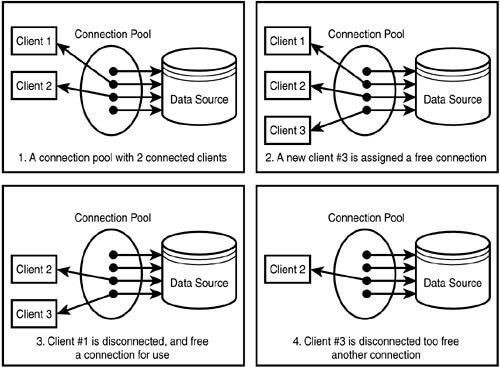When building web applications that use MySQL databases, it’s essential to have a scalable and efficient way to manage database connections. Creating a new database connection for each user request can be slow and inefficient, especially when dealing with high volumes of traffic. This is where connection pooling comes in.
The connection pool a standard way of caching connections in the memory so that they can be reused when needed instead of creating a connection from scratch. The connection pool if implemented correctly offers a significant performance boost.
What is Connection Pooling in database?
Connection pooling is a technique used to manage a pool of database connections that can be reused by multiple user requests. The basic idea is to create a pool of already initialized database connections that can be borrowed and returned to the pool as needed.
When a new user request comes in, the application borrows a connection from the pool, performs the necessary database operations, and then returns the connection back to the pool. This way, the application avoids the overhead of creating and destroying database connections for each request.

Benefits of Connection Pooling in database
Using connection pooling can provide several benefits
- Improved Performance : By using connection pooling, your application can avoid the overhead of creating and destroying database connections for each request. This can significantly improve the performance of your application, especially when dealing with high volumes of traffic.
- Resource Management : Connection pooling can help manage system resources by limiting the number of database connections created and maintained. This can help prevent resource exhaustion and improve the overall stability of the system.
- Scalability : Connection pooling can help your application handle increasing demand by providing a scalable way to manage database connections. By reusing existing connections, your application can handle more requests without experiencing performance issues.
How to Implement Connection Pooling in MySQL
To implement connection pooling in MySQL, you can use a JDBC driver that supports connection pooling. The most commonly used JDBC driver for MySQL is the MySQL Connector/J driver.
Here are the steps to implement connection pooling using the database Connector/J driver:
- Include the MySQL Connector/J driver in your project : The first step is to include the MySQL Connector/J driver in your project. You can download the driver from the official MySQL website or use a dependency management tool like Maven or Gradle to include it in your project.
- Configure the connection pool settings : Next, you need to configure the connection pool settings.
- Create the connection pool : Once the settings are configured, you can create the connection pool.
- Borrow and return connections from the pool : With the connection pool created, your application can now borrow and return connections from the pool as needed.
There are two ways of creating a connection pool:
1. mysql.connector.connect()
2. mysql.connector.pooling.MySQLConnectionPool
To create a connection pool with the connect() function, we pass any one of the following pool related argument to it:
| Argument | Description |
|---|---|
| pool_name | (optional) Name of the connection pool. This parameter is optional and if not specified the pool name will be generated automatically by joining the values from host, port, user, and database connection arguments, in that order. |
| pool_size | (optional) Size of the pool i.e. the number of connection to hold in the pool. This argument is optional and if not specified, it defaults to 5. |
For example,
db = mysql.connector.connect(option_files='my.conf', pool_name='my_connection_pool', pool_size=10)
The above call to connect() function does two things:
- Creates a connection pool named my_connection_pool of size 10.
- Returns the first connection from the pool and assign it to the db variable.
Conclusion:
Using connection pooling in MySQL-based web applications can provide significant performance, scalability, and resource management benefits. By using a JDBC driver that supports connection pooling and configuring the connection pool settings, you can easily implement connection pooling in your application. With connection pooling in place, your application can efficiently manage database connections, even in high-traffic scenarios, and provide a seamless user experience.
Thank You
Pooja TS
Helical IT Solutions

Best Open Source Business Intelligence Software Helical Insight is Here
